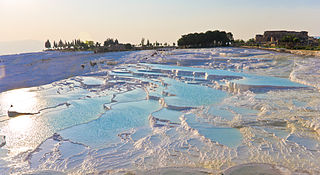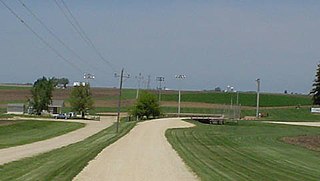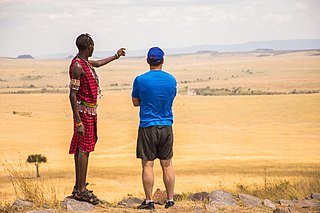Locations
This section needs additional citations for verification .(September 2020) |
Notable movie and television series filming locations that have become popular tourist destinations because of that include:
Film tourism, or film induced tourism, is a specialized or niche form of tourism where visitors explore locations and destinations which have become popular due to their appearance in films and television series. [1] The term also encompasses tours to production studios as well as movies or television-related parks. [2] This is supported by several regression analyses that suggest a high correlation between destinations taking a proactive approach in order to encourage producers/studios to film at their location, and the tourism success in the area after the release of the movie. [3] This is consistent with induced demand theory. When the supply increases, in the form of media exposure to areas that were not regarded as tourist hotspots, the number of visitors increases, even though the majority of these new visitors would not have necessarily visited these areas previously. This is exemplified by a Travelsat Competitive Index study that indicated that in 2017 alone, approximately 80 million tourists made the decision to travel to a destination based primarily on its feature in a television series or film. This figure has doubled since 2015.[ citation needed ]
Film-induced tourism is one of the fastest-growing sectors in tourism currently. [4] It emerged as a prominent form of tourism in the 1990s. Before its emergence as a unique driver of the tourism industry, there were brief mentions of the phenomenon of film tourism by academics and anecdotal mentions.
In 1996, the British Tourism Association became the first tourism agency to capitalize on film tourism by publishing a map of Great Britain with movie locations marked on it. [5]
This increasing popularity of film tourism is due to the rise of international travel, the rapid growth of the entertainment industry, and cult-like celebrity status. [6]
For destinations, films provide long-term tourism revenue. The appearance of a particular area in a film or television can have a huge effect on the number of visitors of an already existing place and create a new kind of tourism to the area and generate a boost for the local economy. On average, a film can increase tourism and revenue by almost 31%. [7]
In New Zealand, fans of The Lord of The Rings movie series visit New Zealand, where most of the movie scenes were shot. The movies increased the annual tourist influx to New Zealand from US$1.7 million in 2000 to US$2.4 million in 2004, a 40 percent surge. [8] [9]
In Britain, the Alnwick Castle, where the scenes for the movie Harry Potter were shot had experienced a 120% increase in visitor numbers which brought an estimated £9 million worth tourist revenue to the area. [10] One of the most prominent examples of film-induced demand is London King's Cross railway station, which was made famous for featuring a fictional section known as platform 9 3/4 in the Harry Potter movie series, first appearing in Harry Potter and the Philosopher's Stone . This fictional location was made into a real attraction in order to entice tourists to visit the train station, and a Harry Potter souvenir shop was constructed to capitalise on the increased interest in the series and the station.
This section needs additional citations for verification .(September 2020) |
Notable movie and television series filming locations that have become popular tourist destinations because of that include:

Tourism is travel for pleasure, and the commercial activity of providing and supporting such travel. UN Tourism defines tourism more generally, in terms which go "beyond the common perception of tourism as being limited to holiday activity only", as people "travelling to and staying in places outside their usual environment for not more than one consecutive year for leisure and not less than 24 hours, business and other purposes". Tourism can be domestic or international, and international tourism has both incoming and outgoing implications on a country's balance of payments.

A tourist attraction is a place of interest that tourists visit, typically for its inherent or an exhibited natural or cultural value, historical significance, natural or built beauty, offering leisure and amusement.

Tourism in Australia is an important part of the Australian economy, and comprises domestic and international visitors. Australia is the fortieth most visited country in the world according to the World Tourism Organization. In the financial year 2018/19, tourism was Australia's fourth-largest export and over the previous decade was growing faster than national GDP growth. At the time it represented 3.1% of Australia's GDP contributing A$60.8 billion to the national economy.

Cultural tourism is a type of tourism activity in which the visitor's essential motivation is to learn, discover, experience and consume the tangible and intangible cultural attractions/products in a tourism destination. These attractions/products relate to a set of distinctive material, intellectual, spiritual, and emotional features of a society that encompasses arts and architecture, historical and cultural heritage, culinary heritage, literature, music, creative industries and the living cultures with their lifestyles, value systems, beliefs and traditions.

The tourism industry has been an important part of the economy of Hong Kong since it shifted to a service sector model in the late 1980s and early 90s. There has been a sharp increase of domestic tourists from Mainland China following the introduction of the Individual Visit Scheme (IVS) in 2003.

Tourism in New Zealand comprised an important sector of the national economy – tourism directly contributed NZ$16.2 billion of the country's GDP in the year ended March 2019. As of 2016 tourism supported 188,000 full-time-equivalent jobs. The flow-on effects of tourism indirectly contributed a further 4.3% of GDP. Despite the country's geographical isolation, spending by international tourists accounted for 17.1% of New Zealand's export earnings. International and domestic tourism contributed, in total, NZ$34 billion to New Zealand's economy every year as of 2017.

Cultural heritage tourism is a form of non-business travel whereby tourists engage with the heritage, tangible and intangible, moveable and immovable, of a region through activities, experiences, and purchases which facilitate a connection to the people, objects, and places of the past associated with the locations being visited. As opposed to natural heritage tourism, which focuses on visitors' interaction with the unimproved environment of the area being visited, including outdoor sports and recreation, hiking, diving, fishing, and naturalism, and pleasure tourism without any heritage interest, such as indoor recreation, gastronomy, and hospitality without any significant precedent in the history and heritage of the region, cultural heritage tourism can include activities such as tours of immovable cultural sites, such as historic house museums, historic fortifications, human history museums, and library documentary heritage collections, opportunities for purchases of moveable cultural property, such as antiques, antiquarian books, and other works and ephemera associated with the locations being visited, and opportunities for admission to or purchase of intangible heritage experiences associated with the tourism region, including gastronomic heritage and admissions to performances such as theatre, opera, ballet, indigenous dances, and storytelling.

Tourism in Turkey is focused largely on a variety of historical sites, and on seaside resorts along its Aegean and Mediterranean Sea coasts. Turkey has also become a popular destination for culture, spa, and health care. Since 2021, Turkey is the fourth most visited country in the world.

Sustainable tourism is a concept that covers the complete tourism experience, including concern for economic, social, and environmental issues as well as attention to improving tourists' experiences and addressing the needs of host communities. Sustainable tourism should embrace concerns for environmental protection, social equity, and the quality of life, cultural diversity, and a dynamic, viable economy delivering jobs and prosperity for all. It has its roots in sustainable development and there can be some confusion as to what "sustainable tourism" means. There is now broad consensus that tourism should be sustainable. In fact, all forms of tourism have the potential to be sustainable if planned, developed and managed properly. Tourist development organizations are promoting sustainable tourism practices in order to mitigate negative effects caused by the growing impact of tourism, for example its environmental impacts.

Pop-culture tourism is the act of traveling to locations featured in popular literature, film, music, or any other form of media. Also referred to as a "Location Vacation".

Tourism is an economic contributor to the Kingdom of Thailand. Estimates of tourism revenue directly contributing to the GDP of 12 trillion baht range from one trillion baht (2013) 2.53 trillion baht (2016), the equivalent of 9% to 17.7% of GDP. When including indirect travel and tourism receipts, the 2014 total is estimated to be the equivalent of 19.3% of Thailand's GDP. The actual contribution of tourism to GDP is lower than these percentages because GDP is measured in value added not revenue. The valued added of the Thailand's tourism industry is not known. According to the secretary-general of the Office of the National Economic and Social Development Council in 2019, the government projects that the tourism sector will account for 30% of GDP by 2030, up from 20% in 2019,Thailand expects to receive 80 million visitors in 2027.
Tourism in Greenland is a relatively young business area of the country. Since the foundation of the national tourist council, Greenland Tourism, in 1992, the Home Rule Government has been working actively with promoting the destination and helping smaller tourist providers to establish their services. Foreign travel agencies have increasingly been opening up sale of Greenland trips and tours, and the cruise industry has had a relatively large increase in routes to Greenland since about the turn of the century.

Tourism in Vietnam is a component of the modern Vietnamese economy. In 2019, Vietnam received 18 million international arrivals, up from 2.1 million in the year 2000. The Vietnam National Administration of Tourism is following a long-term plan to diversify the tourism industry, which brings foreign exchange into the country.

Tolkien tourism is a phenomenon of fans of Tolkien's fiction making media pilgrimages to sites of film- and book-related significance. It is especially notable in New Zealand, site of the movie trilogy by Peter Jackson, where it is credited as having raised the annual tourism numbers.

Tourism in Kenya is Kenya's third largest source of foreign exchange revenue, following diaspora remittances and agriculture. The Kenya Tourism Board is responsible for maintaining information about tourism in Kenya.

Tourism in Morocco is well developed, maintaining a strong tourist industry focused on the country's coast, culture, and history. The Moroccan government created a Ministry of Tourism in 1985. Tourism is considered one of the main foreign exchange sources in Morocco and since 2013 it had the highest number of arrivals out of the countries in Africa. In 2018, 12.3 million tourists were reported to have visited Morocco.
Tourism Radio is a travel technology company based in Cape Town, South Africa, which produces location-based technology used in customized GPS in-car devices and IOS and Android mobile applications. The technology allows the user to take a tour of a city or pre-defined area, with geo-located, pre-recorded audio travel information triggering automatically as the user approaches them. The Tourism Radio in-car device plugs into a standard vehicle cigarette lighter and broadcasts a selection of local and international music along with location-specific travel information about the area the vehicle is driving through. Currently, there are approximately 3,300 of these devices used in South Africa, Namibia, New Zealand and Angola. Distribution of the devices to tourists is done in partnership with local Destination Marketing Organisations (DMOs) and car/motorhome rental agencies. The iOS and Android applications do not broadcast a selection of music, but use the same geo-location principle to give the user relevant travel information about the area they are in. This includes information about a general area or suburb, as well as information about specific points of interest, such as museums, art galleries, historical attractions, restaurants, nature walks, beaches, etc.

Slum tourism, poverty tourism, ghetto tourism or trauma tourism is a type of tourism that involves visiting impoverished areas, or in some cases, areas that were affected by disasters, such as nuclear fallout zones like Chernobyl or Fukushima. Originally focused on the slums and ghettos of London and Manhattan in the 19th century, slum tourism is now prominent in South Africa, India, Brazil, Kenya, Philippines and the United States.
Tourism impacts tourist destinations in both positive and negative ways, encompassing economic, political, socio-cultural, environmental, and psychological dimensions.

Overtourism is the congestion or overcrowding from an excess of tourists, resulting in conflicts with locals. The World Tourism Organization (UNWTO) defines overtourism as "the impact of tourism on a destination, or parts thereof, that excessively influences perceived quality of life of citizens and/or quality of visitor experiences in a negative way". This definition shows how overtourism can be observed both among locals, who view tourism as a disruptive factor that increasingly burdens daily life, as well as visitors, who may regard high numbers of tourists as a nuisance.